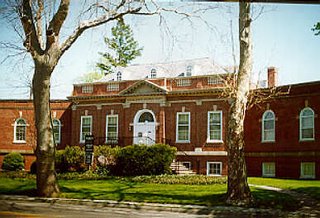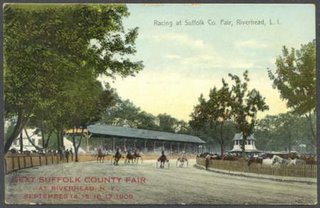
Monday, August 07, 2006
Historical Organizations, Riverhead, NY
Visit:
Suffolk County Historical Society
300 West Main Street
Riverhead, New York 11901-2894
(631)727-2881
Founded in 1886 to collect, preserve and interpret the ongoing history of Suffolk County, the Suffolk County Historical Society houses a unique collection of artifacts reflecting more than three centuries of change. Step back in time and sail with sea captains to distant shores. Explore the culture of Algonquin people and their relationship with the European settlers. See the furniture, tools and personal belongings that were part of the everyday lives of Suffolk's pioneers. Research your family, church, village or town in the library and archival collections with the help of the library staff. A few hours here will lead you through Suffolk County's rich and colorful past.
The library and archives contain an extensive collection of historical and genealogical holdings about Suffolk county's history and its people. The diverse collections include books, periodicals, newspapers, photographs, and family papers of many different types.
Public programs for organized groups, adults and children focus on themes that reflect Suffolk's rich cultural heritage. School programs cover a broad range of topics designed to supplement the classroom study of local history. Advanced registration is required for these programs.
In the Weathervane Gift Shop, visitors will find a large selection of historical books, maps, reproductions, antiques, craft items and cards. A variety of genealogical supplies is also available.
The museum is open Tuesday through Saturday 12:30 p.m. to 4:30 p.m. admission is free, however donations are welcome. The library is open Wednesday,Thursday & Saturday 12:30 p.m. to 4:30 p.m.. A $2.00 donation is required from non-members for library use. The Suffolk County Historical Society is easily reached via Nugent Drive from the L.I.E. or via Moriches- Riverhead Road from Sunrise Highway.
Suffolk County Historical Society
300 West Main Street
Riverhead, New York 11901-2894
(631)727-2881
Founded in 1886 to collect, preserve and interpret the ongoing history of Suffolk County, the Suffolk County Historical Society houses a unique collection of artifacts reflecting more than three centuries of change. Step back in time and sail with sea captains to distant shores. Explore the culture of Algonquin people and their relationship with the European settlers. See the furniture, tools and personal belongings that were part of the everyday lives of Suffolk's pioneers. Research your family, church, village or town in the library and archival collections with the help of the library staff. A few hours here will lead you through Suffolk County's rich and colorful past.
The library and archives contain an extensive collection of historical and genealogical holdings about Suffolk county's history and its people. The diverse collections include books, periodicals, newspapers, photographs, and family papers of many different types.
Public programs for organized groups, adults and children focus on themes that reflect Suffolk's rich cultural heritage. School programs cover a broad range of topics designed to supplement the classroom study of local history. Advanced registration is required for these programs.
In the Weathervane Gift Shop, visitors will find a large selection of historical books, maps, reproductions, antiques, craft items and cards. A variety of genealogical supplies is also available.
The museum is open Tuesday through Saturday 12:30 p.m. to 4:30 p.m. admission is free, however donations are welcome. The library is open Wednesday,Thursday & Saturday 12:30 p.m. to 4:30 p.m.. A $2.00 donation is required from non-members for library use. The Suffolk County Historical Society is easily reached via Nugent Drive from the L.I.E. or via Moriches- Riverhead Road from Sunrise Highway.
Sunday, July 30, 2006

Riverhead (pop.around 2500) lies just to the north of Sevenoaks in Kent and probably derives its name from the Saxon "rither", meaning a hill.
Riverhead Parish Council celebrated its centenary in 1994. Riverhead's most famous resident was General Sir Jeffery Amherst, who built his house "Montreal" (long since demolished) here after conquering Canada in the mid-18th century.
Several acres of the former grounds of Montreal are now owned by the Parish Council and maintained as public parkland. There are some 30 listed buildings in the Riverhead Conservation Area and the church of St Mary was designed by Decimus Burton. Next to the church is the village hall which is available for hire and also houses the Parish Clerk's office
The town encompasses the communities of Aquebogue, Baiting Hollow, Calverton, Jamesport, Northville, Riverhead and Wading River.
Once known for its Long Island duck farms
Local festivals include:·
Railroad Festival - Aug. 26-27, 2006Dates often change. Check Riverhead web sites and events links in the sections below. 2006 dates will be added as they become available.
Riverhead Blues Festival ( just Started )
Riverhead attractions:
Atlantis Marine World Aquarium
Polish Town Story:

Polish Town is a small neighborhood in Riverhead settled by Polish immigrants at the turn of the century. They came to this country for several reasons, the most important of which was the religious persecution which developed after Poland was divided among Russia, Prussia and Austria. They also came seeking jobs that would enable them to save enough to bring their families to the new world. Since agriculture was their main line of work in Poland - a country whose very name means "the land of fields" - it was natural for them to come to the rich farmlands of eastern Long Island and work on the local farms.
The early Polish immigrants to Polish Town did more than work the farms. Twenty young men joined together and pledged themselves into a Polish fraternity. The name of this organization was "Towarzystwo Polskie Rzymsko - Katolickie Bratnies Pomocy pod Opieka Sw. Izydora, Patrona Rolnikow" - "The Polish Roman Catholic Society of Fraternal Assistance under the Patronage of St. Isidore, The Patron of Farmers". They built a church of wood with twin spires with their own hard-earned pennies. St. Isidore's Church, named after the patron saint of the farmer was built in 1906 and is the oldest Polish Roman Catholic Church on Long Island. The church became the focal point and spiritual heart of the little community known as Polish Town.
The modest homes in Polish Town were made of clapboard and the shops were one story buildings where Polish was spoken. You could shop for clothes, food and anything else you needed without speaking a word of English. The families met at St. Isidore's for their worship, weddings, christenings and funerals. Community functions were held at the Riverhead Polish Hall which was incorporated in 1907. The first building was burnt down and the present structure was built about 1925. Polish Town consists of an area of approximately 15 blocks which includes residential, commercial and industrial properties. Pulaski Street, formerly called Cemetery Street, is the main east-west thoroughfare. On October 9, 1929, the Riverhead Town Board, with the unanimous approval of the residents residing on Cemetery Street, passed a resolution sponsored by the Riverhead Polish Hall, to change Cemetery Street to Pulaski Street.
At the time, there was local and national observance of the 150th anniversary of the death of General Casimir Pulaski, who died in the service of our country during the Revolutionary War. Polish settlers in Riverhead's Polish Town area came from Russia, Prussia and Austria. What is now called Polish Town was virtually unsettled prior to Polish immigration. By 1905, the Polish Town community became established. Many of the descendants of these early immigrants are still in the area - many still on the land purchased by their forefathers. In less than two generations, the descendants of these Polish immigrants are Riverhead's land and homeowners, public officials, business people, doctors, lawyers, teachers, merchants, tradesmen and farmers.
Subscribe to:
Posts (Atom)
